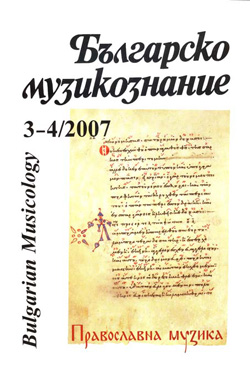Йоасаф Рилски
Joasaph of Rila
Author(s): Svetlana KujumdzievaSubject(s): Music
Published by: Институт за изследване на изкуствата, Българска академия на науките
Summary/Abstract: Joasaph of Rila is a distinguished music teacher and composer. According to some new evidences found, he lived between 1780 and 1852. Joasaph left two inscriptions in two copies of the book containing Service for St. John of Rila that was sponsored by him and published by Neophit of Rita in 1836. The inscriptions prove that he was Bulgarian by birth: he was born in village of Rajovo near the town of Samokov in the south-western part of Bulgaria. His activity was linked to the Rita monastery, and especially to the Rita singing school, one of the greatest singing schools in the Balkans during the 18th and 19th century. According to Neophit of Rita Joasaph, as a Rita monk, was sent to Mount Athos in 1802 to learn the Eastern chant. He spent 10 years there and after his coming back to the monastery in 1812, he was appointed as a teacher of this chant there. In 1816 Joasaph was sent for six months to Istanbul to learn the “New Method” that was established by the three “teachers”: Chrysantos, Chourmusius and Grigorios Protopsaltis. Coming back for the second time to the Rila monastery, Joasaph was the first to teach this method at the Rila singing schoAs a composer, Joasaph wrote pieces in Greek and Slavic. His works are found in 15 manuscripts preserved now at the library of the Rila monastery and at the two monasteries on Mount Athos Xenophontos and Dionisiatos. The pieces are labeled as “translations”, “interpretations” (“exegeseis”) and “original” works. They were designated for the Great Vespers, the three liturgies (the Liturgy of St. John Chrysostomos, the Liturgy of St. Basil the Great and the Liturgy of the Presanctified Gifts), for some special services like the beginning of the new church year (September 1), Pasha, the Elevation of the Cross (September 14), etc. The study of the pieces reveals virtuosity and invention and represents Joasaph as both fine chant teacher and composer. The pieces, also, represent Bulgarian contribution to the development of the Balkan Orthodox music at the time of Joasaph.
Journal: Българско музикознание
- Issue Year: 2007
- Issue No: 3-4
- Page Range: 192-201
- Page Count: 9
- Language: Bulgarian
- Content File-PDF

